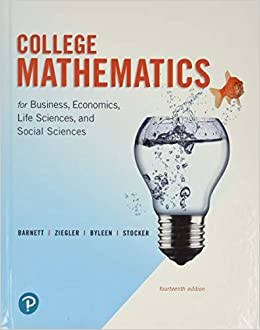Answered step by step
Verified Expert Solution
Question
1 Approved Answer
Complete the following: 1. Chapter 5: problem sets, numbers 5, 6, and 11, and CFA problems, numbers 1 and 10 2. Chapter 6: problem sets,
Complete the following: 1. Chapter 5: problem sets, numbers 5, 6, and 11, and CFA problems, numbers 1 and 10 2. Chapter 6: problem sets, number 21, and CFA problems, number 2 APA format is not required, but solid academic writing is expected. Answers should be submitted using an Excel spreadsheet in order to show all calculations, where applicable. 5. Suppose your expectations regarding the stock market are as follows: State of the Economy Probability HPR Boom 0.3 44% Normal growth 0.4 14 Recession 0.3 216 Use Equations 5.65.8 to compute the mean and standard deviation of the HPR on stocks. (LO 5-4) 6. The stock of Business Adventures sells for $40 a share. Its likely dividend payout and end-of-year price depend on the state of the economy by the end of the year as follows: (LO 5-2) Dividend Stock Price Boom $2.00 $50 Normal economy 1.00 43 Recession .50 34 a. Calculate the expected holding-period return and standard deviation of the holdingperiod return. All three scenarios are equally likely. www.mhhe.com/bkm b. Calculate the expected return and standard deviation of a portfolio invested half in Business Adventures and half in Treasury bills. The return on bills is 4%. 11. Consider a risky portfolio. The end-of-year cash flow derived from the portfolio will be either $50,000 or $150,000, with equal probabilities of .5. The alternative riskless investment in T-bills pays 5%. (LO 5-3) a. If you require a risk premium of 10%, how much will you be willing to pay for the portfolio? b. Suppose the portfolio can be purchased for the amount you found in ( a ). What will the expected rate of return on the portfolio be? c. Now suppose you require a risk premium of 15%. What is the price you will be willing to pay now? d. Comparing your answers to ( a ) and ( c ), what do you conclude about the relationship between the required risk premium on a portfolio and the price at which the portfolio will sell? 1. A portfolio of nondividend-paying stocks earned a geometric mean return of 5% between January 1, 2005, and December 31, 2011. The arithmetic mean return for the same period was 6%. If the market value of the portfolio at the beginning of 2005 was $100,000, what was the market value of the portfolio at the end of 2011? 10. Probabilities for three states of the economy and probabilities for the returns on a particular stock in each state are shown in the table below. State of Economy Probability of Economic State Stock Performance Probability of Stock Performance in Given Economic State Good .3 Good .6 Neutral .3 Poor .1 Neutral .5 Good .4 Neutral .3 Poor .3 Poor .2 Good .2 Neutral .3 Poor .5 What is the probability that the economy will be neutral and the stock will experience poor performance? Chapter 6 21. The following figure shows plots of monthly rates of return and the stock market for two stocks. (LO 6-5) a. Which stock is riskier to an investor currently holding her portfolio in a diversified portfolio of common stock? b. Which stock is riskier to an undiversified investor who puts all of his funds in only one of these stocks? 2. George Stephensons current portfolio of $2 million is invested as follows: Summary of Stephensons Current Portfolio Value Percent of Total Expected Annual Return Annual Standard Deviation Short-term bonds $ 200,000 10% 4.6% 1.6% Domestic large-cap equities 600,000 30 12.4 19.5 Domestic small-cap equities 1,200,000 60 16.0 29.9 Total portfolio $2,000,000 100% 13.8% 23.1% Stephenson soon expects to receive an additional $2 million and plans to invest the entire amount in an index fund that best complements the current portfolio. Stephanie Coppa, CFA, is evaluating the four index funds shown in the following table for their ability to produce a portfolio that will meet two criteria relative to the current portfolio: (1) maintain or enhance expected return and (2) maintain or reduce volatility Each fund is invested in an asset class that is not substantially represented in the current portfolio. Index Fund Characteristics Index Fund Expected Annual Return Expected Annual Standard Deviation Correlation of Returns with Current Portfolio Fund A 15% 25% 10.80 Fund B 11 22 10.60 Fund C 16 25 10.90 Fund D 14 22 10.65 State which fund Coppa should recommend to Stephenson. Justify your choice by describing how your chosen fund best meets both of Stephensons criteria. No calculations are required
Step by Step Solution
There are 3 Steps involved in it
Step: 1

Get Instant Access to Expert-Tailored Solutions
See step-by-step solutions with expert insights and AI powered tools for academic success
Step: 2

Step: 3

Ace Your Homework with AI
Get the answers you need in no time with our AI-driven, step-by-step assistance
Get Started


